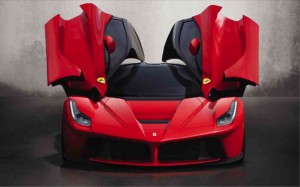Ferrari, McLaren push the performance and styling envelopes
It was the worst of times; it was the best of times. As parts of the world grapple with economic recession and stagnation, demand for ultra-luxury goods continues to soar. It is in this environment that Ferrari and McLaren, two Formula One rivals extraordinaire that are also in the business of making hyper-performance road cars, are releasing their latest creations.
LaFerrari
The name may be awkward (Have you ever imagined calling a car “The The Maserati”?) but everything else about the car is jaw dropping. The LaFerrari reportedly embodies everything that the company knows about building an automobile including Formula One technology, distilled into a road car.
At the heart of the limited-production supercar is a hybrid drivetrain. This is no Prius, though—the LaFerrari uses its HY-KERS, standing for Hybrid-Kinetic Energy Recovery System as in Formula One, to boost performance. There’s no electric-only mode, although that may be used in future versions of the drivetrain. The internal combustion engine is a 6.2-liter V12, good for 792 hp. With a high compression ratio, the engine can rev to 9250 rpm, amazing for such a large displacement. The engine is paired with a 161 hp electric motor, for a staggering total of 953 hp. The batteries, mounted on the car’s floor, are recharged while the car is braking, or even when the V12 is producing more torque that required for driving, such as when cornering. A dual-clutch transmission sends power to the wheels. Like any hybrid, another benefit is to cut emissions. Emissions are 40-percent lower than a Bugatti Veyron’s, and at par with cars like the Daewoo Musso 2.3-liter, of all things.
Performance is staggering: 0-100 kph in less than three seconds, and 0-200 kph in less than seven seconds. Lap time at Ferrari’s factory race track, Fiorano, is five seconds faster than the Enzo and three seconds faster than the F12 berlinetta, making the car the fastest road car from Maranello by quite a margin.
The bodywork is dramatic and worthy of a sports prototype car. F1-inspired aerodynamic aids are evident throughout the design. The car is hand-assembled from different types of carbon fiber, using the same design and production techniques as Fernando Alonso’s Sunday car. Indeed, Alonso and Felipe Massa were purportedly involved in the car’s tuning. It’s priced at one million Euros, or $1.3 million. If you haven’t received an invitation to buy one, it’s probably too late. Only 499 units will be made for the company’s most loyal customers.
McLaren P1
Across the pond, La Prancing Horse’s great Formula One rival has also been busy. After jumping into the high-performance road car market once again with its all-carbon chassis (and also awkwardly named) MP4-12C. The new car has a simpler moniker. Specifications are eerily similar to the LaFerrari: 0-100 kph in less than three seconds, and 0-200 kph in less than seven. 0-300 kph in 17 seconds, a whole five seconds faster than the legendary F1 road car. Top speed is 350 kph. One difference is that the McLaren can go all-electric, at up to 20 km at an average speed of 48 kph. This will enable the car to enter European cities’ zero-emissions zones, or go for a midnight ramen run without waking the neighbors.
The P1 uses a twin-turbo 3.8-liter V8, like the 12C’s, but with larger turbos. The engine is paired with an electric motor for a combined 903 hp and 900 Nm of torque. McLaren says that the electric assist allows the drivetrain to behave more like a naturally aspirated engine. Emissions are even less than the LaFerrari’s, by a third. Emissions drop to zero when the car is in electric mode.
The McLaren’s chassis is also constructed from carbon fiber, for lightness and stiffness. A huge rear wing pops up from the curvaceous rear deck for greater downforce at speed. If you must ask, the McLaren’s priced at $1.288 million; the P1 is even more exclusive than the LaFerrari, at 375 units.
When the McLaren F1 was created, speculation was that its performance would never be topped, given new emissions and noise regulations. Then came the Bugatti Veyron, which was again touted as the standard that wouldn’t be surpassed. Formula One organizers like to justify the sport by saying that technology from the racing cars trickles down to road cars. Well, they never said what kind of cars they would trickle down to. By using Formula One technology in its latest exotics, Ferrari and McLaren are pushing the performance and styling envelopes much further than what was previously possible.




